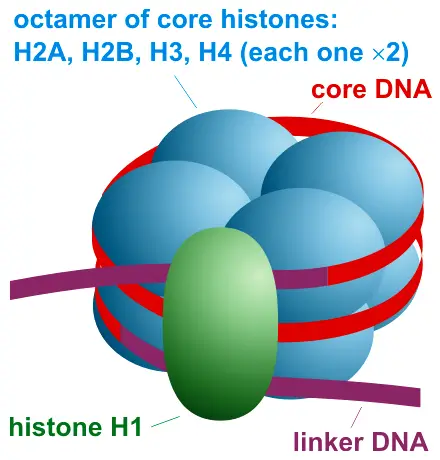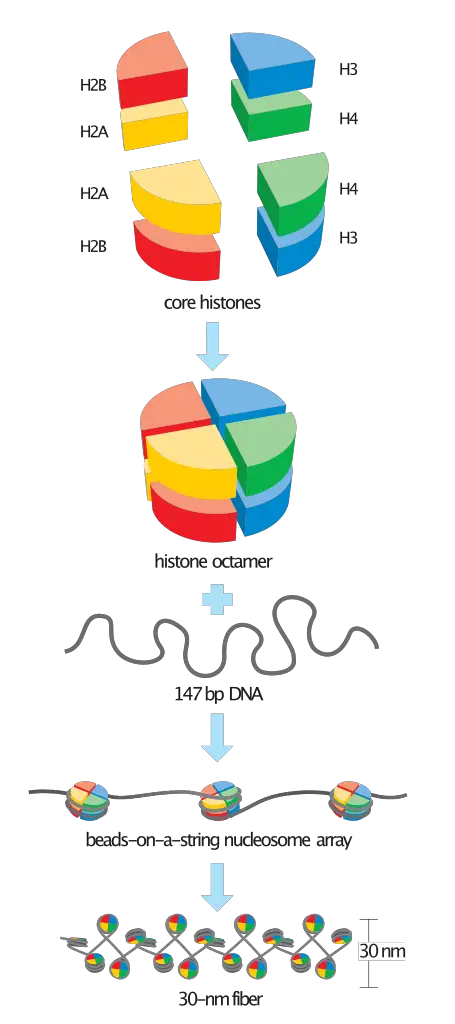What Are The Functions of Nucleosome in DNA? Let’s Know!
We all know that a single diploid human cell can contain about 6.6 x 109 base pairs of DNA which roughly constitutes a length of about 2.2 metres.
So, how come such a very long DNA fit into the nucleus of the cell?
That’s by the packaging of DNA. The DNA supercoils itself with the help of various proteins to get a compressed shape so that it can fit and be packaged inside the nucleus of the cell.
The DNA of all eukaryotes is wrapped around positively charged histone protein octamer to form a nucleosome. Histones are rich in lysine and arginine amino acids that are positively charged.
Chromatin is a dynamic and highly organised structure that plays a role in all aspects of chromatin biology and controls access to DNA. The basic repeating unit of chromatin is the nucleosome, an octamer of histone proteins wrapped around twice with DNA.
Let’s know more about the nucleosome and its functions…


(Image Source: David O Morgan / Attribution)
What are the functions Of nucleosome in DNA?
1. A nucleosome is the basic structural unit of DNA packaging in eukaryotes. It helps in the packaging of DNA to fit inside the cell’s nucleus.
2. Nucleosome forms the fundamental repeating unit of chromatin because it comprises of about 146 base pairs of DNA wrapped around a core of 8 histone proteins.
3. The packaging of DNA into nucleosomes shortens the DNA fiber length by about 7 times. In other words, a piece of DNA that is 1 meter long will become a chromatin fiber just 14 centimeters long.
4. Within the nucleus, histone proteins of the Nucleosome provide the electrostatic energy to fold DNA. As a result, chromatin can be packaged into a much smaller volume than DNA alone.
5. Histone proteins of the nucleosome are basic proteins, and their positive charges allow them to associate with DNA, which is negatively charged. Some histones function as spools for the thread-like DNA to wrap around.
6. Nucleosomes help in controlling the replication and transcription of the DNA. As the whole length of DNA is packaged firmly by the nucleosomes, thus only allowing a small section of the DNA to replicate and transcript by providing a barrier to the enzymes that unwind and copy DNA. As a result, the whole DNA doesn’t take part in replication and transcription which is very important for conservational gene expression in the biological body.
7. Nucleosome provides the DNA with the ability to coil and uncoil whenever required. It is important to remember that these processes are reversible, so modified or remodeled chromatin can be returned to its compact state after transcription and/or replication are complete.
8. The nucleosomes in chromatin fibers are seen as ‘beads-on-string’ structure under the electron microscope. These chromatin fibers with the help of the nucleosomes can further undergo condensation at the metaphase stage of cell division which results in the formation of chromosomes.
9. Nucleosome positions in the genome is a very important factor in determining the accessibility of the DNA during gene expression. Nucleosomes regulate the accessibility of the transcription machinery to DNA, and function as a basic layer in the complex regulation of gene expression.
10. Nucleosomes carry the epigenetically inherited information in the form of chemical modifications of their core histones. The transcriptional processing of DNA during the gene expression is largely controlled by the epigenetic regulation of the nucleosomes.
What are nucleosomes? What are they made of?
Nucleosomes are the basic packing unit of DNA built from 8 histone proteins (histone octamer) around which the DNA helix strand is coiled.
The histone octamer is made of lysine and arginine amino acids giving it a positive charge.
Nucleosomes are required in order to fit DNA into the nucleus. This nucleosome helps in the packaging of the long DNA strand into a highly compacted structure known as chromatin.
A nucleosome is simply a structure formed through interactions between DNA and histone proteins. The DNA is negatively charged and the histone proteins give the core of the nucleosome a positive charge, as a result, DNA wraps around the nucleosome.
A nucleosome is made up of both DNA strand and the histone octamer. Here, a histone octamer is formed from the presence of a pair of histones H2A, H2B, H3, and H4, although in some cases other histone variants may also be found in the core (e.g., H2A.Z, MacroH2A, H2a.Bbd, H2A.lap1, H2A.X, H3.3, CenH3 and others).
A chain of nucleosomes can be arranged in a 30 nm fiber, a compacted structure and whose formation is dependent on the presence of the H1 histone.
A 147bp segment of DNA then wraps around the histone octamer for about 1.75 times, thus completing the formation of a single nucleosome.
The DNA double helix in every cell is very tightly bound to an equal mass of histone proteins, which forms nucleosomes. The nucleosomes are further packaged (coiled) to form a chromatin fiber of various nucleosomes.
Various such chromatin fibers are further coiled to form a chromatid thread of a chromosome. In humans, each cell normally contains 23 pairs of chromosomes, for a total of 46.
What is the function of histones in the nucleosome of DNA?
1. Histone gives structural support to the DNA to wrap around its octamer (8 histone proteins) thus leading to DNA coiling in order to fit it inside the cell’s nucleus.
2. Histones give a positive charge to the nucleosome, and thus the negatively charged DNA strand gets wrapped around the histone octamer. Electrostatic interactions can be seen between the histone octamer and the wrapped DNA.
3. Some variants of histones are associated with the regulation of gene expression. And so, they are very important for the regulation of genes.
4. Histones act as a tight lock to hold the DNA and coil it thus decreasing the DNA length. And if that lock is opened or removed, a gene gets out. So they turn out to have very important functions, not only structurally, but also in the regulation of gene function in the expression.
5. Modifications to histones are referred to as the histone code. Even though not much is known about these modifications, it has been found that gene regulation is one purpose for it.
6. The addition of methyl (—CH3) group to a histone can turn gene expression ON or OFF depending on which histone is modified by a methyl group. For example, adding 3 methyl groups to H3 will repress gene expression for any genes that are near the methylated H3 histone.
7. There are five families of histones (H1 through H5). H2A, H2B, H3, and H4 are the core histones, and H1 and H5 are the linker histones. The core histones from the center of the nucleosome, hence the term ‘core.’ The linker histones are found at the entrance and exit sites of the nucleosome and lock the DNA in place, hence the term ‘linker.’
8. Histones are alkaline (basic) in nature. The highly basic nature of histones not only helps in the DNA-histone interactions but also contributes to their water solubility.
9. In addition to organizing DNA and making it more compact, histones play an important role in determining which genes are active.
Why is DNA packaging so important?
A very important function of the nucleosome is DNA packaging. The histones that make up the nucleosome help in a variety of mechanisms both physically and chemically in coiling and supercoiling the DNA for the purpose of packaging.
So, why is DNA packaging so important?
In each living human cell’s nucleus, there is DNA of 2.2 metre length. DNA packaging allows the 7 billion base pairs of the DNA in each diploid cell to fit into space of just 6 microns across.
DNA packaging is very much necessary as this process saves a lot of space for other biological activities to take place in the cell together with carrying a lot of genetic information as well.
Moreover, DNA packaging does not allow the replication and transcription to take place rapidly until and unless needed to do so, because it’s very important to preserve the genetic information stored in the DNA and also for keeping room for other cellular activities to take place.
Whenever required, a small sequence of DNA unpacks itself using a bit of biochemical energy and enzymatic reactions, and only that part of the DNA is replicated and transcribed without affecting the whole length of the DNA.
DNA packaging is also very important as the two strands of DNA cannot unwind in the entire length due to high energy requirements. This is very important in order to save the biochemical energy of the body to run other metabolic activities as well.
